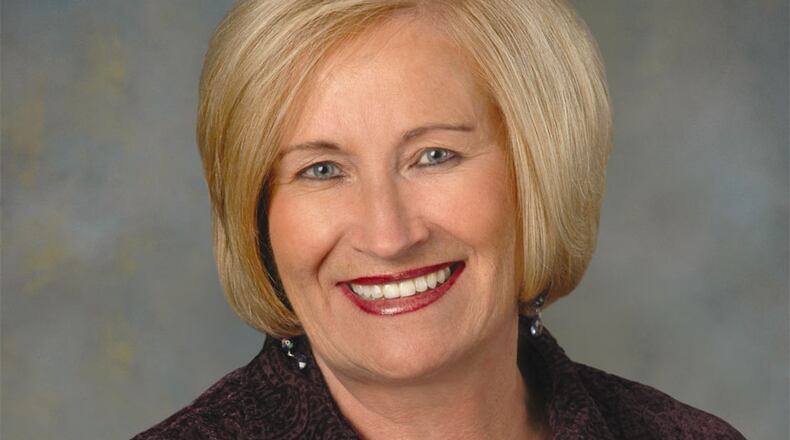Clark State Community College by the numbers
4,139 students in fall 1997
8,564 students in fall 2011
250 full-time and 700 part-time employees
$100 million cumulative resource development in the past 10 years
80 degree and certificate programs
Karen Rafinski
- 2008 Outstanding Community College President by the Association of Community College Trustees
- Member of the board of directors for the Greater Springfield Chamber of Commerce, board member for the Dayton Development Coalition and Community Mercy Medical Center Foundation
- Past chairwoman of the Southwest Ohio Colleges of Higher Education and Ohio College Association, past president of the Council of North Central Two-Year Colleges
- Participates on boards and committees of Junior Achievement, United Way, Center City Association and president of Leadership Clark County.
- 41 years in higher education
- 26 years in presidencies at three institutions
- As a high school senior, a counselor tried to discourage Rafinski from going to college
- Rafinski and her husband, John, want to travel in her retirement but plan to remain in the area
The woman who oversaw Clark State Community College during a period of rapid growth, new buildings and expanded online courses will retire next year.
Karen Rafinski, Clark State president, will end her 16-year tenure with the college in June 2013. Under her leadership, Clark State’s enrollment more than doubled as it expanded to serve more students in more locations and has been a major player in economic and workforce development.
“They’re critical to the success of our community, our community moving forward and developing the workforce that we’re trying to create in Springfield … “(Rafinski) has been around the table on every big deal that we’ve done in the community and has been able to participate in a creative way to help get those deals done,” said Mike McDorman, chamber president and CEO.
Enrollment has increased from 4,139 students in the fall of 1997 to 8,564 in the fall of 2011. In the past ten years, Clark State has raised $100 million through the Clark State Foundation and grants, and the foundation ranks first among all Ohio community colleges in its endowment funds per student, according to the college.
“There’s never really a good time (for transition) but I think this is better than most,” Rafinski said. “The college is on good, strong footing and I’ve got a year left.”
Under her tutelage, Clark State has grown and matured into one of the finest colleges of its type in the country, said former U.S. Rep. David Hobson.
“In the early stages, we just kind of looked at Clark State as an educational institution … Now we look at it as more than an educational institution, we look at it as a job opportunity for high-tech work in the area,” he said.
The college went from offering four classes online to more than 130, and now boasts more than 80 degree and certificate programs. It also opened a Greene County campus in Beavercreek, which Rafinski considers one of her greatest accomplishments as president.
Clark State is a major employer with 250 full-time employees and 700 part-time employees.
“It’s a major employer in itself but then it does a lot of training and experience for people within our community who can improve their lives by training at Clark State,” Hobson said. “That bolsters our community, it helps individuals come to our community when they get the kind of employees that they need.”
One of the college’s primary roles is workforce development, Springfield Mayor Warren Copeland said.
“They’re sort of our front line for training, educating people in the community,” he said. “Increasingly workforce is a key issue that employers are looking for in deciding whether to come to a community or not and, once they’re here, whether to expand here or not.”
Clark State developed training to create a workforce that would allow CodeBlue to expand in Springfield. The company has about 230 employees now and plans to continue to grow here.
“In our case, it’s a multimillion dollar example of how they help people transition from unemployed to gainful employed,” said Paul Gross, president and CEO of CodeBlue. “It’s a multimillion (dollar) annual impact in terms of the economic development or prosperity that she brought to town, contributed to as a result of her leadership and vision and innovative approach.”
Rafinski has spent 41 years in higher education, with 26 of those in presidencies at three institutions.
Only 25 percent of community college presidents and CEOs have served more than 10 years in their position, according to the American Association of Community Colleges.
“It’s a long tenure for a presidency, period,” she said. “I’ve been most fortunate in having just a wonderful community and a wonderful set of bosses through my board of trustees.”
The college’s board expects to conduct a nationwide search to fill the position.
“I don’t think we need a person to reinvent the wheel,” said McDorman. “We need someone that knows the landscape and can take what has been done and keep moving us as a community college and as a community in the direction of being successful.”
Rafinski took risks as Clark State’s president and any successor should look to do the same, said state Sen. Chris Widener, R-Springfield.
“Any community college president has just got to be an innovator first and foremost and they have to be aggressive,” he said. “They have to be willing to roll up their sleeves, put some resources at risk and work with employers to come up with programs that make a difference in people’s lives.”
About the Author
